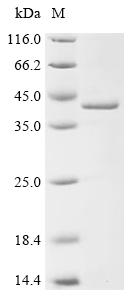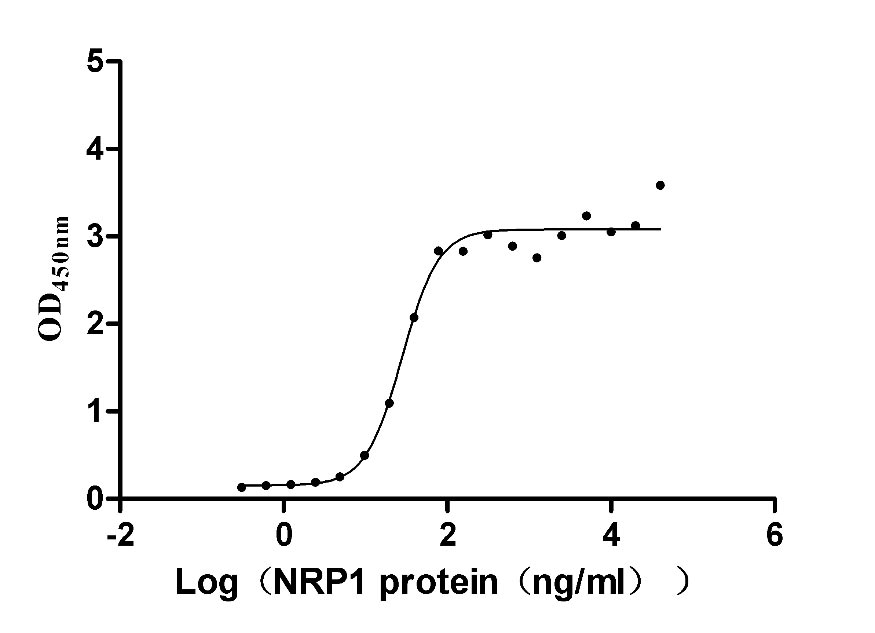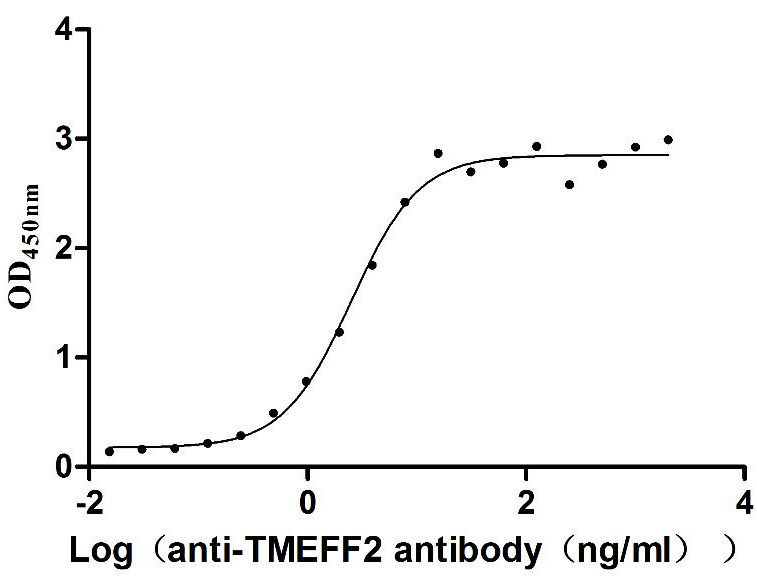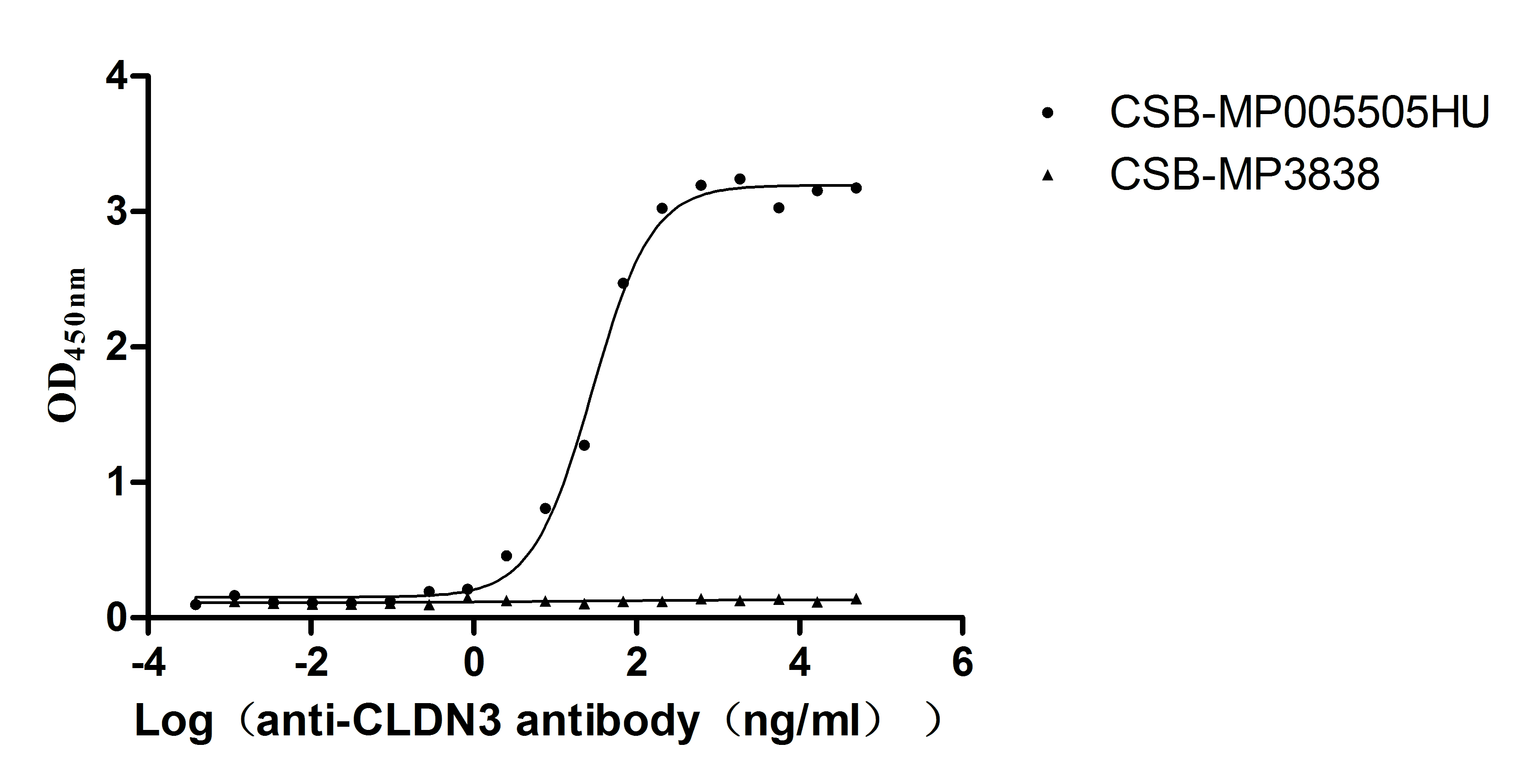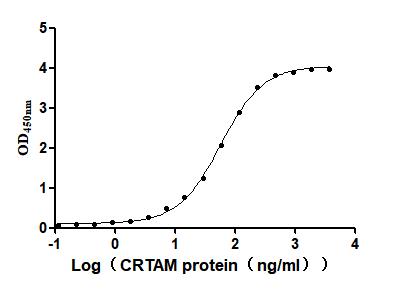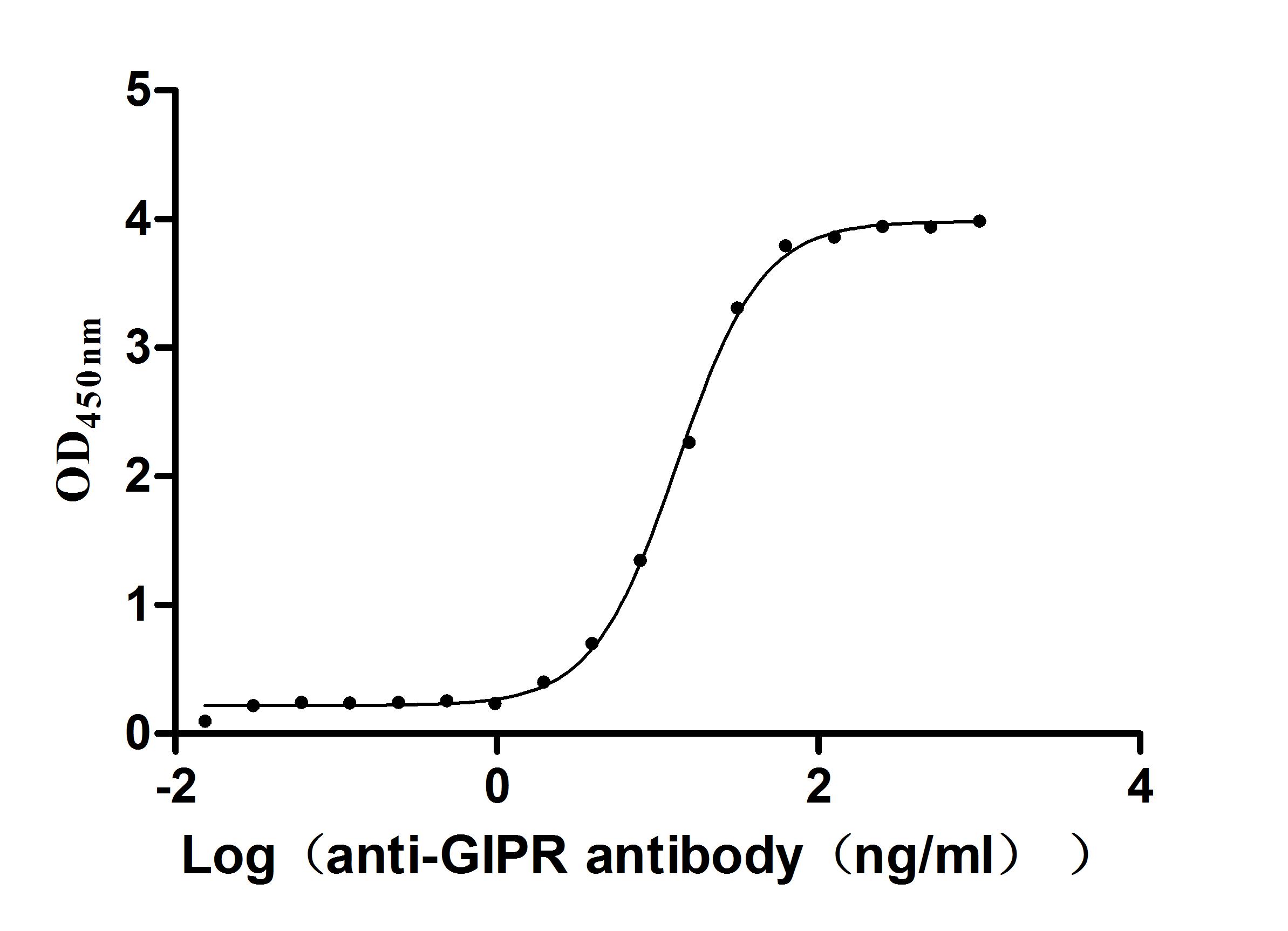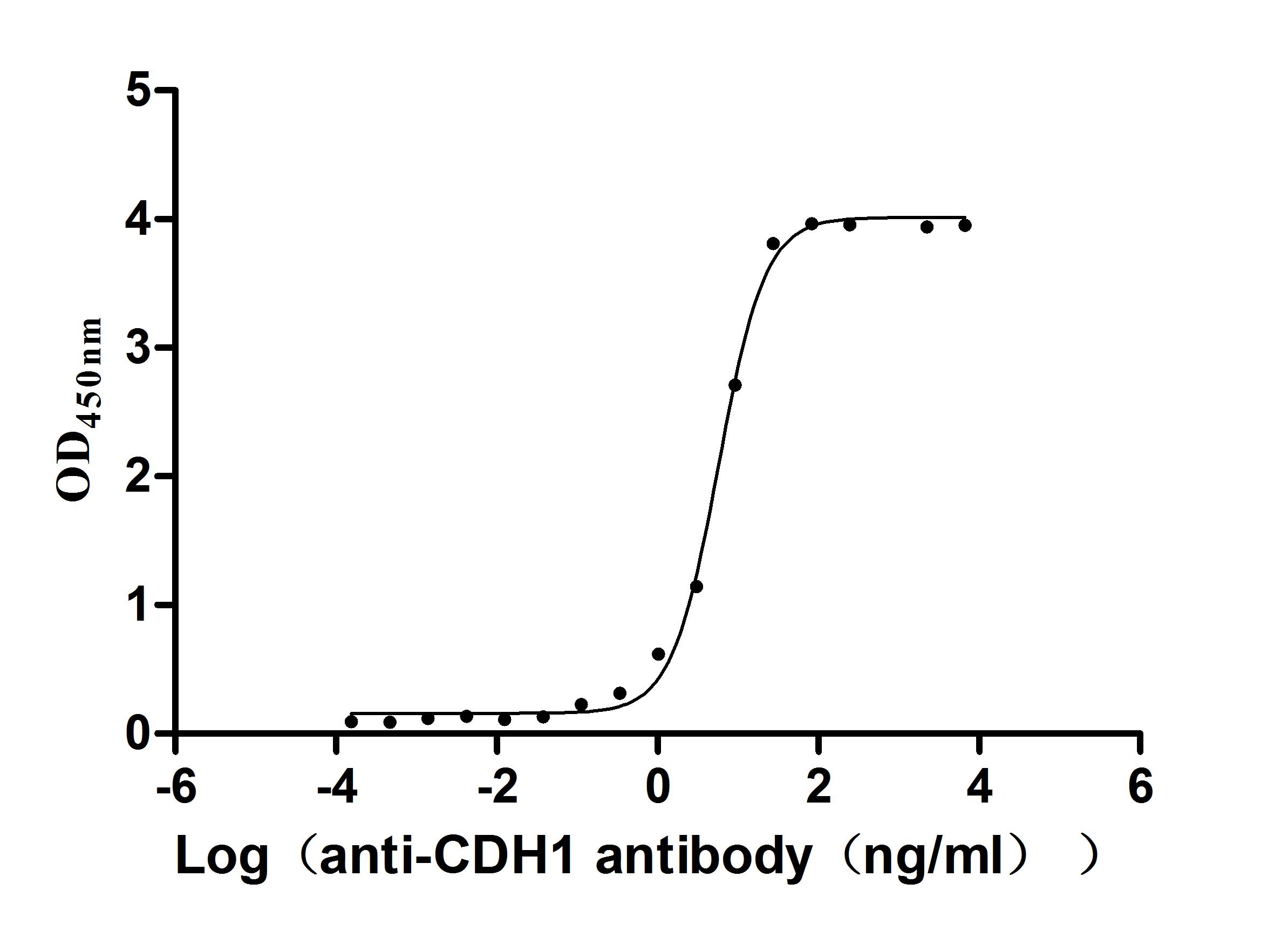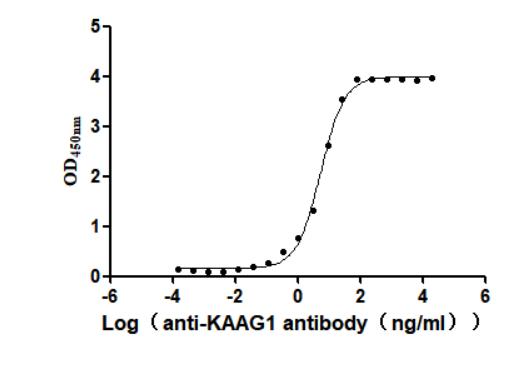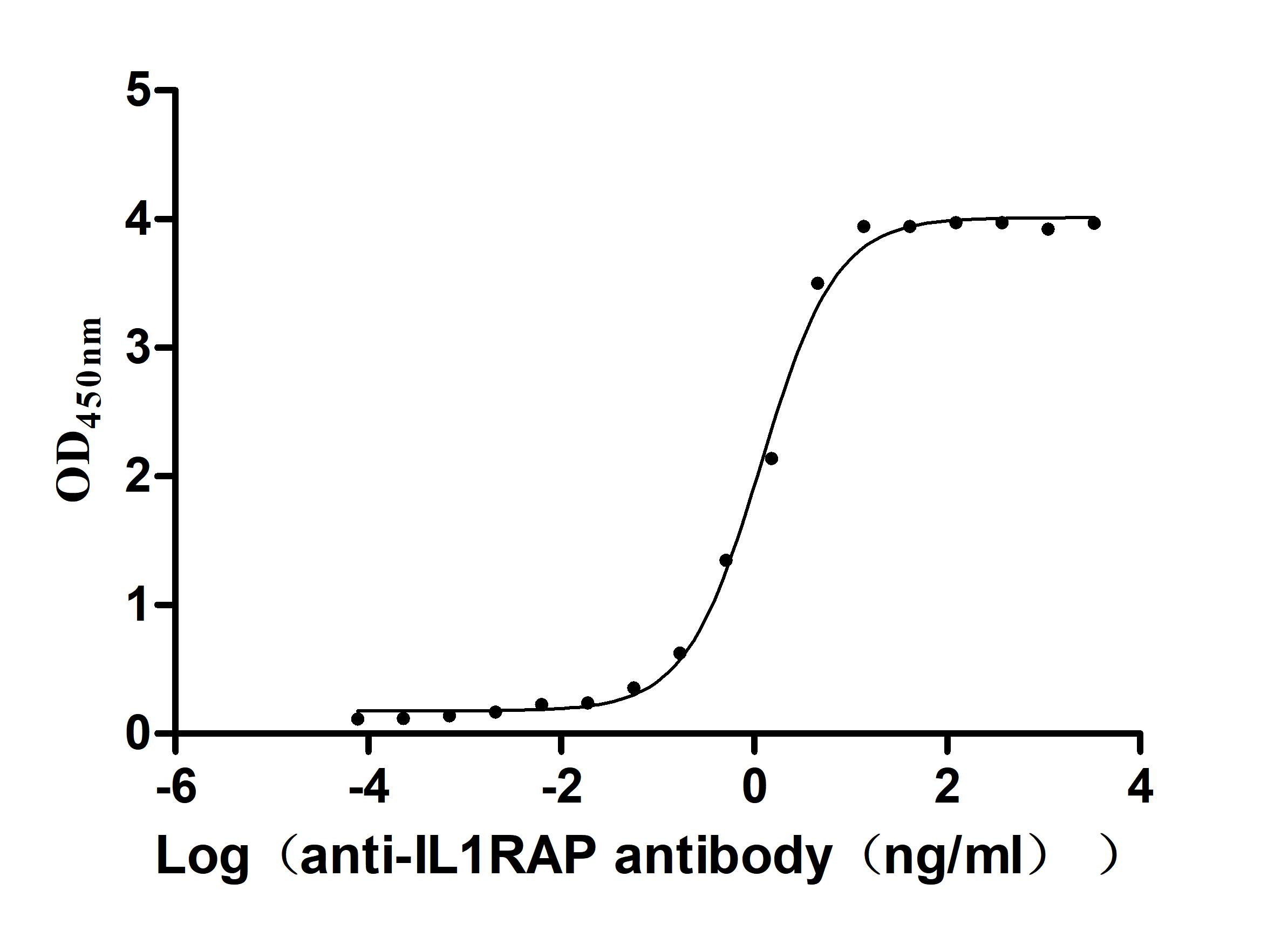Recombinant Human Fatty acid-binding protein, liver (FABP1)
In Stock-
中文名稱(chēng):人FABP1重組蛋白
-
貨號(hào):CSB-EP007940HU
-
規(guī)格:¥1344
-
圖片:
-
其他:
產(chǎn)品詳情
-
純度:Greater than 90% as determined by SDS-PAGE.
-
生物活性:Not Test
-
基因名:
-
Uniprot No.:
-
別名:Fatty acid-binding protein 1;Liver-type fatty acid-binding protein;L-FABP
-
種屬:Homo sapiens (Human)
-
蛋白長(zhǎng)度:Full Length
-
來(lái)源:E.coli
-
分子量:41.7 kDa
-
表達(dá)區(qū)域:1-127aa
-
氨基酸序列MSFSGKYQLQSQENFEAFMKAIGLPEELIQKGKDIKGVSEIVQNGKHFKFTITAGSKVIQNEFTVGEECELETMTGEKVKTVVQLEGDNKLVTTFKNIKSVTELNGDIITNTMTLGDIVFKRISKRI
Note: The complete sequence may include tag sequence, target protein sequence, linker sequence and extra sequence that is translated with the protein sequence for the purpose(s) of secretion, stability, solubility, etc.
If the exact amino acid sequence of this recombinant protein is critical to your application, please explicitly request the full and complete sequence of this protein before ordering. -
蛋白標(biāo)簽:N-terminal GST-tagged
-
產(chǎn)品提供形式:Liquid or Lyophilized powder
Note: We will preferentially ship the format that we have in stock, however, if you have any special requirement for the format, please remark your requirement when placing the order, we will prepare according to your demand. -
緩沖液:If the delivery form is liquid, the default storage buffer is Tris/PBS-based buffer, 5%-50% glycerol. If the delivery form is lyophilized powder, the buffer before lyophilization is Tris/PBS-based buffer, 6% Trehalose.
-
復(fù)溶:We recommend that this vial be briefly centrifuged prior to opening to bring the contents to the bottom. Please reconstitute protein in deionized sterile water to a concentration of 0.1-1.0 mg/mL.We recommend to add 5-50% of glycerol (final concentration) and aliquot for long-term storage at -20℃/-80℃. Our default final concentration of glycerol is 50%. Customers could use it as reference.
-
儲(chǔ)存條件:Store at -20°C/-80°C upon receipt, aliquoting is necessary for mutiple use. Avoid repeated freeze-thaw cycles.
-
保質(zhì)期:The shelf life is related to many factors, storage state, buffer ingredients, storage temperature and the stability of the protein itself.
Generally, the shelf life of liquid form is 6 months at -20°C/-80°C. The shelf life of lyophilized form is 12 months at -20°C/-80°C. -
貨期:3-7 business days
-
Datasheet & COA:Please contact us to get it.
相關(guān)產(chǎn)品
靶點(diǎn)詳情
-
功能:Plays a role in lipoprotein-mediated cholesterol uptake in hepatocytes. Binds cholesterol. Binds free fatty acids and their coenzyme A derivatives, bilirubin, and some other small molecules in the cytoplasm. May be involved in intracellular lipid transport.
-
基因功能參考文獻(xiàn):
- urinary level associated with the chronic kidney disease classification in HIV-infected patients, but not associated with antiretroviral therapy and tenofovir disoproxil fumarate PMID: 27761670
- Both peak oxygen consumption and grip strength were inversely associated with urinary L-FABP levels in middle-aged and older individuals without chronic kidney disease. PMID: 28197733
- Nonrenal conditions and systemic severity should be considered for improved AKI prediction by NGAL and L-FABP as biomarkers. PMID: 27605390
- urine L-FABP/C is permanently elevated in chronic kidney disease patients. PMID: 28745927
- Our data suggests that the polymorphism in genes IL-1beta, IL-1Ra and FABP1 included in this study are not associated with PCOS development, but can influence important biochemical and metabolic parameters in PCOS. PMID: 28405733
- On PICU day 1, interleukin-18 predicted acute kidney injury with area under the curve=0.82, but neutrophil gelatinase-associated lipocalin and liver fatty acid binding protein predicted acute kidney injury with area under the curve of less than or equal to 0.69; on PICU day 2, area under the curve was higher. Interleukin-18 and liver fatty acid binding protein on day 1 predicted prolonged acute kidney injury. PMID: 28430754
- In total, 68 miRNAs potentially targeting FABP1 were selected; of these, miR-3941, miR-4517, and miR-4672 directly targeted the FABP1 3' untranslated region. Mimics of the three miRNAs substantially repressed FABP1 expression at translational level and led to HepG2 cell resistance to steatosis and cell injury induced by free fatty acids mixture, which rescue of FABP1 overexpression reversed. PMID: 29258109
- This study demonstrated that the loss of FABP1 expression is associated with MSI carcinomas and that interferon gamma stimulation plays a role in this process via its interaction with PPARgamma. PMID: 27687006
- Hepatic adenomas co-occurring with fibrolamellar carcinomas show LFABP loss and are negative for PRKACA rearrangements, indicating they are genetically distinct lesions. These data also demonstrate that LFABP loss, which characterizes HNF1-alpha inactivation, is a consistent feature of fibrolamellar carcinoma, indicating HNF1-alpha inactivation is an important event in fibrolamellar carcinoma pathogenesis. PMID: 27015136
- studies indicate that FABP1 is essential for proper lipid metabolism in differentiated enterocytes, particularly concerning fatty acids uptake and its basolateral secretion. PMID: 28919479
- CDH5 and FABP1 expression levels were both elevated in drug-induced liver injury. PMID: 27224670
- A high resolution NMR comparative molecular analysis of L-FABP T94T and L-FABP T94A in their unbound states and in the presence of representative ligands of the fatty acid and bile acid classes showed that threonine to alanine replacement did not result in strongly perturbed structural and dynamic features, although differences in oleic acid binding by the two variants were detected. PMID: 28668637
- Studies show that despite overall tertiary structure similarity, the hFABP1 differs significantly from rat FABP1 in secondary structure, much larger ligand binding cavity, and affinities/specificities for some ligands. Moreover, while both mouse and hFABP1 mediate ligand induction of PPARA, they differ markedly in genes induced. hFABP1 T94A variant is associated with altered body mass index.[review] PMID: 27117865
- analysis of structural, dynamic, and binding properties of the liver fatty acid binding protein (LFABP) in crowded solutions PMID: 27457417
- Urinary L-FABP, NGAL, Kim-1 and albumin levels increased during the acute phase of kidney injury and were significantly correlated with the degree of tubulointerstitial fibrosis during the chronic phase. These markers could detect higher risk of progression to CKD. PMID: 27028054
- L-FABP was found to associate with VEGFR2 on membrane rafts and subsequently activate the Akt/mTOR/P70S6K/4EBP1 and Src/FAK/cdc42 pathways, which resulted in up-regulation of VEGF-A accompanied by an increase in both angiogenic potential and migration activity. L-FABP significantly promoted tumor growth and metastasis in a xenograft mouse model. PMID: 26919097
- In chronic kidney disease, high urinary L-FABP correlated with the development of end-stage renal disease and cardiovascular disease. PMID: 26189083
- In the association of SNPs in FABP1 gene with PCOS, rs2197076 was more closely associated with its main features than rs2241883 and seemed to play a more important role in the pathogenesis of PCOS. PMID: 26650609
- Report interaction of perfluoroalkyl acids with human liver fatty acid-binding protein. PMID: 25370009
- Urinary L-FABP appears to be a sensitive biomarker of acute kidney injury in patients undergoing abdominal aortic repair. PMID: 26585768
- Urinary levels of NGAL are more sensitive than uKIM-1 and uL-FABP levels in predicting renal scarring in vesicoureteral reflux. PMID: 26324091
- Loss of staining for LFABP appears to be common in hepatocellular carcinoma and may be seen in well-differentiated hepatocellular carcinoma. PMID: 26997447
- In this study, the effects of hepatitis B virus X protein (HBx) mediated FABP1 regulation on hepatic steatosis and the underlying mechanism were determined. PMID: 26637457
- compared with the rs2919872 G allele, the rs2919872 A allele reduces the transcriptional activity of FABP1 promoter, and thereby may link FABP1 gene variation to triglyceride level in humans. PMID: 26439934
- Higher urinary L-FABP was found in pregnant with and without gestational diabetes mellitus(GDM), and considerably higher urinary L-FABP was found in the GDM group compared with the non-GDM group. PMID: 26254248
- Multivariable regression analysis revealed that urinary L-FABP and urinary albumin/ creatinine ratio were significantly associated with urinary ACE2 levels. PMID: 26067610
- Measurement of uL-FABP levels at 48 h after coronary angiography may be useful in detecting renal damage, and in predicting 1-year renal outcome in ischemic heart disease patients undergoing CAG. PMID: 24554034
- Measurement of urinary L-FABP and albumin/creatinine ratio should be useful to assess cardiovascular damage reflecting the elevation of cardiac markers and ECG abnormalities in T2DM with CKD. PMID: 24626813
- Urinary L-FABP is strongly associated with anemia in non-diabetic patients. PMID: 26010898
- L-FABP is a novel biomarker of diverse kidney diseases. (Review) PMID: 25797895
- I-FABP and L-FABP are early markers for abdominal injury with limited prognostic value for secondary organ failures in the post-traumatic course PMID: 25324448
- Both the MTP I128T and the L-FABP T94A polymorphisms can affect serum lipid levels in the Chinese population. PMID: 25663234
- The study investigates the interaction of L-FAB with phospholipid liposomes. PMID: 25198387
- The human FABP1 T94A variant protein had 3-fold higher cholesterol-binding affinity than the WT FABP1. PMID: 25732850
- In smaller HCC, L-FABP downregulation probably occurs because of phenotypic changes during tumor progression. Moreover, this downregulation correlated with tumor differentiation and intratumoral inflammation. PMID: 25516669
- FABP1 and FABP2 have roles in differentially modulating the activation of PPARalpha in a ligand-selective manner PMID: 25847235
- Maternal serum LFABP level appears to be correlated with the severity of the preeclampsia and can be used to confirm the diagnosis. PMID: 25399315
- Data suggest that up-regulation of urinary levels of LFABP, KIM1 (kidney injury molecule 1), and NGAL (neutrophil gelatinase associated lipocalin) can be used as biomarkers to reflect tubular dysfunction in early-stage type 2 diabetic nephropathy. PMID: 24687388
- There is not a significant association between the FABP1 polymorphisms and aspirin-exacerbated respiratory disease(AERD). PMID: 25338211
- Urinary L-FABP was an accurate predictor of early renal allograft function. PMID: 25027586
- Increased serum L-FABP levels are associated with delayed graft function. PMID: 24750195
- Baseline urinary L-FABP levels can be a predictor for occurrence of contrast-induced kidney disease. PMID: 23604313
- L-FABP was downregulated in hepatocellular carcinoma and was associated with poor prognosis. PMID: 25436304
- It has investigated the interaction between human L-FABP and the soluble domain of Plasmodium falciparum UIS3 by NMR spectroscopy. PMID: 23169100
- NGAL, IL-18, KIM-1, L-FABP, and albumin differed between etiologies and were significantly higher in patients adjudicated with acute kidney injury. PMID: 24375576
- Human FABP1 T94A variant impacts fatty acid metabolism and PPAR-alpha activation in cultured human female hepatocytes. PMID: 24875102
- although the T94A substitution did not alter the affinity of human L-FABP for long chain fatty acids, it significantly altered human L-FABP structure and stability PMID: 24628888
- Data suggest that an SNP in FABP1 (T94A) does not alter affinity of FABP1 for PPARalpha agonists (fibrates); this SNP does alter FABP1 secondary structure, stability, and functional response to fibrates (gene expression up-regulation in hepatocytes). PMID: 24299557
- L-FABP was not significantly associated with acute kidney injury in adults or children after adjusting for other kidney injury biomarkers (neutrophil gelatinase-associated lipocalin and IL-18). PMID: 23599408
- MS and NMR were used to study the ligand binding of human liver fatty acid binding protein. Results are consistent for 2 binding sites with different affinity; results indicate a higher affinity for oleate relative to palmitate at each binding site. PMID: 23893635
顯示更多
收起更多
-
亞細(xì)胞定位:Cytoplasm.
-
蛋白家族:Calycin superfamily, Fatty-acid binding protein (FABP) family
-
數(shù)據(jù)庫(kù)鏈接:
Most popular with customers
-
Recombinant Human Neuropilin-1 (NRP1) (Active)
Express system: Mammalian cell
Species: Homo sapiens (Human)
-
Recombinant Human Tomoregulin-2 (TMEFF2), partial (Active)
Express system: Mammalian cell
Species: Homo sapiens (Human)
-
Recombinant Human Claudin-3 (CLDN3)-VLPs (Active)
Express system: Mammalian cell
Species: Homo sapiens (Human)
-
Recombinant Mouse Cytotoxic and regulatory T-cell molecule (Crtam), partial (Active)
Express system: Mammalian cell
Species: Mus musculus (Mouse)
-
Recombinant Macaca fascicularis Gastric inhibitory polypeptide receptor (GIPR), partial (Active)
Express system: yeast
Species: Macaca fascicularis (Crab-eating macaque) (Cynomolgus monkey)
-
Recombinant Human Cadherin-1(CDH1),partial (Active)
Express system: Mammalian cell
Species: Homo sapiens (Human)
-
Recombinant Human Kidney-associated antigen 1(KAAG1) (Active)
Express system: Baculovirus
Species: Homo sapiens (Human)
-
Recombinant Human Interleukin-1 receptor accessory protein (IL1RAP), partial (Active)
Express system: Mammalian cell
Species: Homo sapiens (Human)

